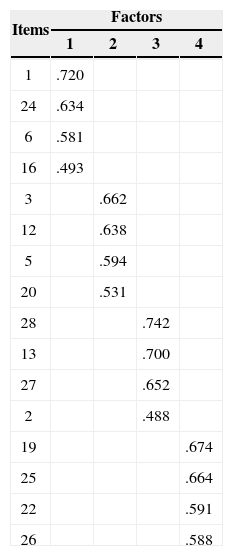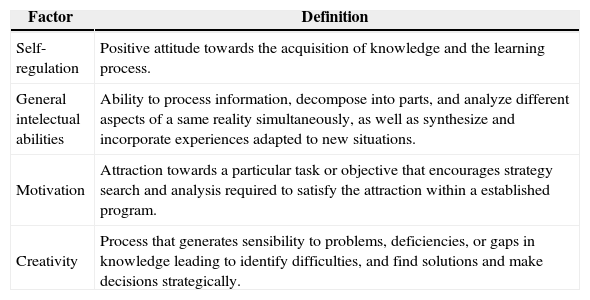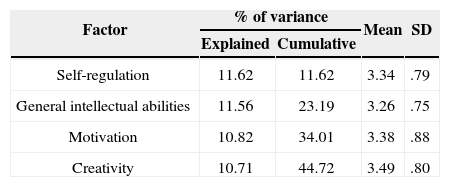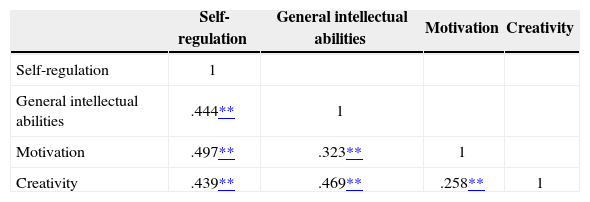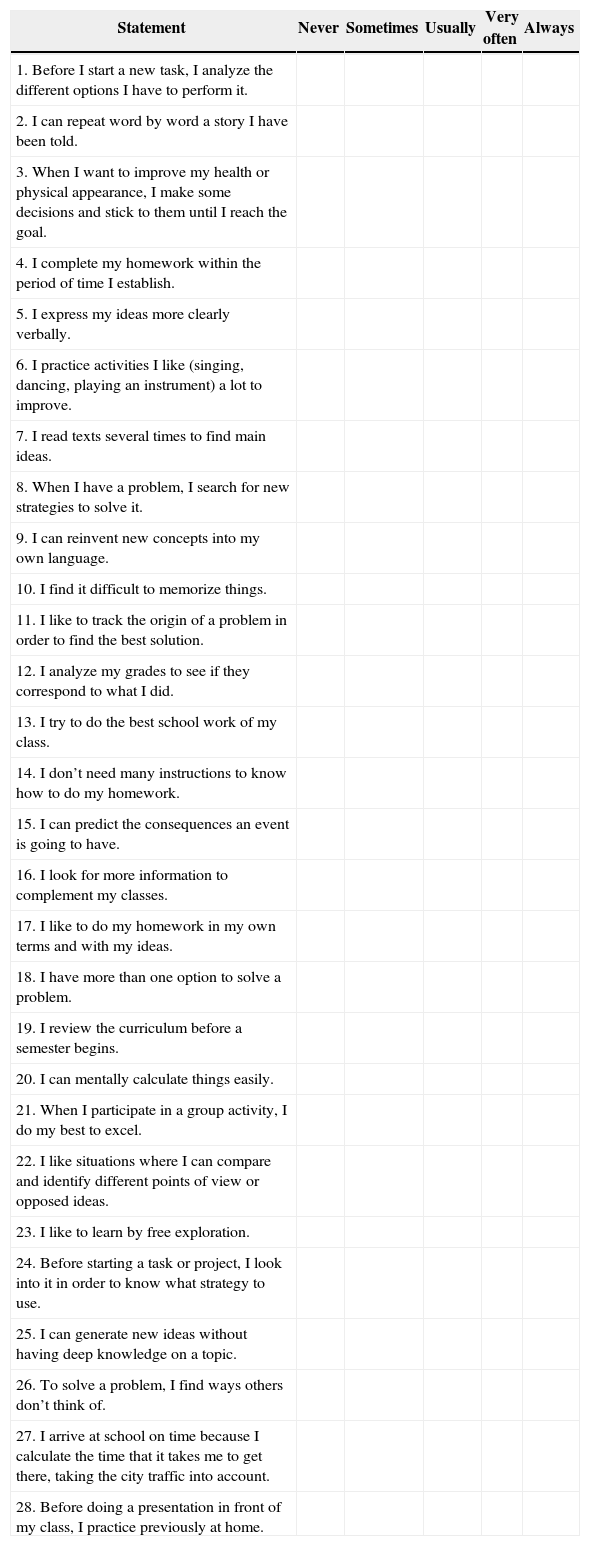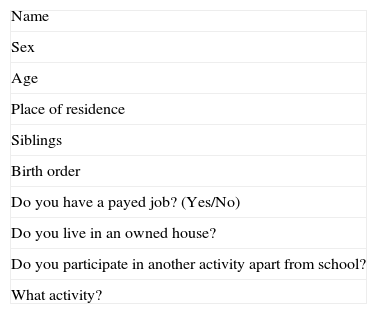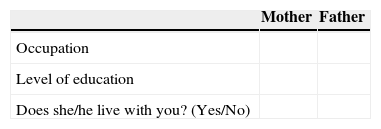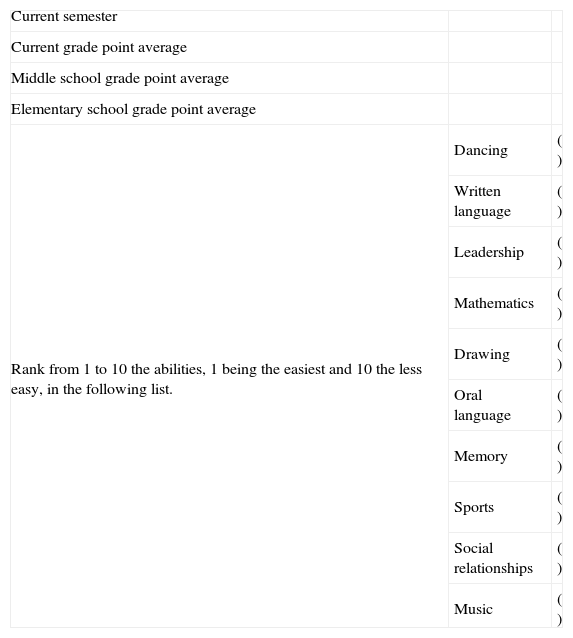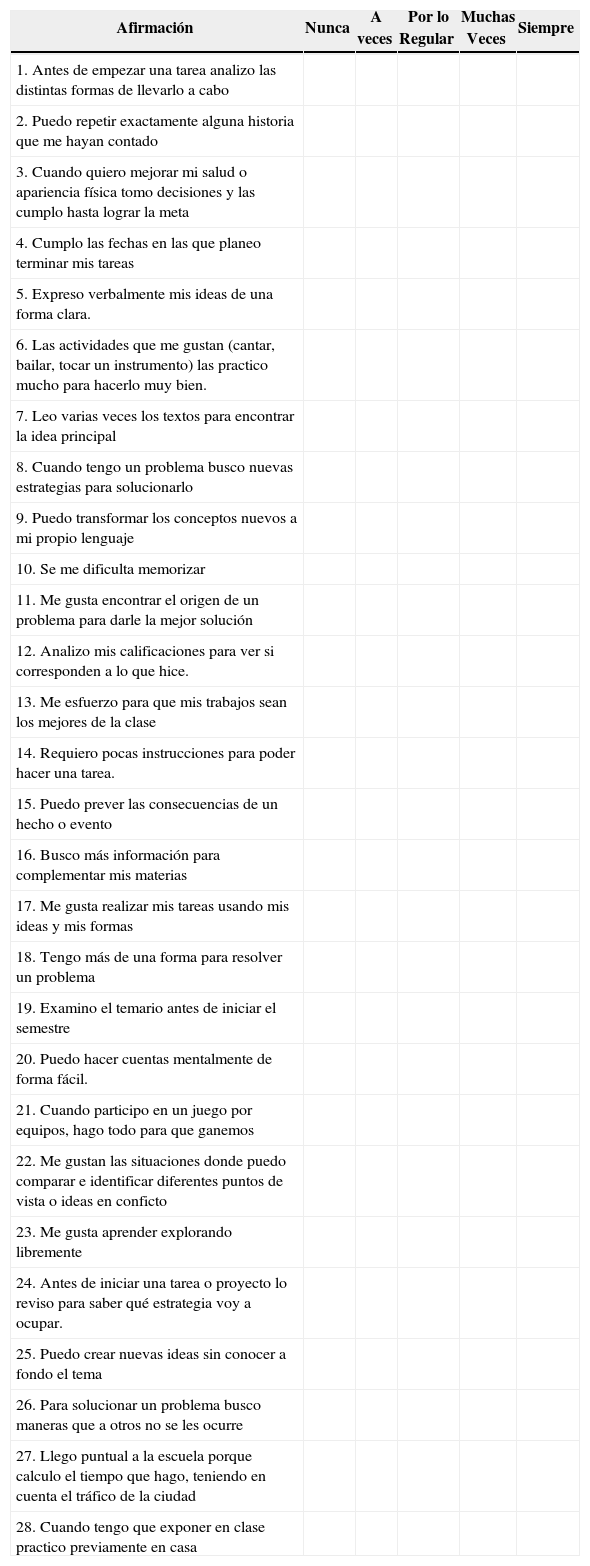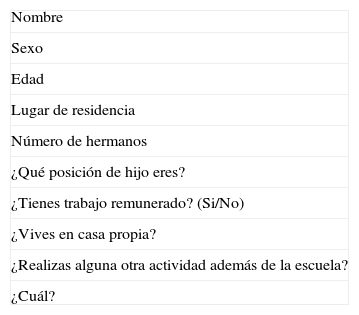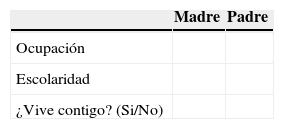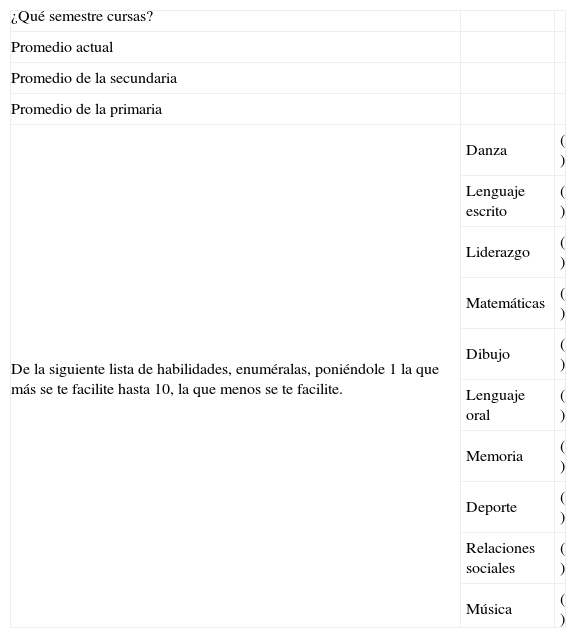Academic self-concept is the perception that a student has about his/her own academic abilities, constitutes one of the most relevant variables in the academic world, because of its influence on learning and cognitive functioning. Self-concept is a general assessment; nevertheless the current measurement instruments used for this construct are specific rather than general. Thus the purpose of this study was to construct and validate an academic self-concept scale with global dimensions, focused on teenager students. In its first stage, an open questions survey was designed to be applied with the intent of knowing the academic activities inside and outside the school. Afterwards, a closed questions survey was applied to a sampling consisting of 347 students ranging 14 to 18 years old from a public high school, east of México City. After obtaining the internal consistency and the items differentiation, a factorial analysis with orthogonal rotation was developed. The results grouped 16 items in 4 factors: self-regulation, general intellectual abilities, motivation and creativity. The scale shows 44.72% of a varying with a global Cronbach Alpha of .828. The present study contributes with an innovative scale with appropriate psychometric features, which globally assesses the academic self-concept.
El autoconcepto académico es la percepción que un estudiante tiene sobre sus habilidades académicas, constituye una de las variables más relevantes dentro del escenario escolar, pues incide significativamente en el funcionamiento cognoscitivo y en el aprendizaje. El autoconcepto es una valoración global, no obstante, los instrumentos actuales que evalúan este constructo no cumplen con dicha característica, miden dimensiones específicas. De aquí que el propósito del presente estudio fue construir y validar una escala de autoconcepto académico con dimensiones globales para estudiantes adolescentes. En un primer momento se desarrolló un cuestionario de preguntas abiertas con la finalidad de conocer las actividades académicas dentro y fuera de la escuela. Posteriormente se elaboró un cuestionario cerrado. Éste último se aplicó a una muestra de 347 estudiantes de entre 14 y 18 años de edad, de un bachillerato público del oriente de la Ciudad de México. Después de obtener la consistencia interna y la discriminación de reactivos, se realizó un análisis factorial con rotación ortogonal. Los resultados agruparon 16 reactivos en 4 factores: autorregulación, aptitudes intelectuales generales, motivación y creatividad. La escala explica el 44.72% de la varianza, con un alpha de Cronbach global de .828. El presente trabajo aporta una escala renovadora con propiedades psicométricas adecuadas, que evalúa de forma global el autoconcepto académico.
Academic self-concept is the perception and evaluation that a student has or does about his or her academic abilities (Marsh & Rhonda, 2002). This self-concept is one of the most important variables in the academic domain, due to its significant influence on appropriate cognitive functioning (Santana, Feliciano, & Jiménez, 2009). It directly affects learning processes (Vidals, 2005), academic achievement, and expectations of students (Henson & Heller, 2000). Additionally, it helps to create various cognitive and self-regulative strategies (Zimmerman, 2000), which refect on academic performance (Campo-Arias et al., 2005; Schunk, Printrich, & Meece, 2008).
Academic self-concept is multidimensional (Shavelson, Hubner, & Staton, 1976). Many studies consider each academic subject area as a dimension, e.g., history, science, mathematics, spanish (Marsh, 1993; Shavelson et al., 1976). However, most research focuses only on spanish and mathematics, setting other taken subjects aside (Marsh & Shavelson, 1985; Plucker & Stocking, 2001). This causes some problems associated with evaluation and self-concept, especially when viewed in adolescents.
First, as individuals grow, the number of dimensions they can handle increases (Campo-Arias et al., 2005; González-Pineda, Núñez, & Valle, 2002; Marsh & Shavelson, 1985); therefore, if only two dimensions are used, evaluation is not thorough. Similarly, it is important to note that each dimension of academic self-concept has a different value and when dimensions are clustered together, a compensation effect among them is shown. Low self-concept in a subject area is compensated for by high self-concept in another one (González-Pineda, Núñez, González-Pumariega, & García, 1997; Marsh, 1993; Shavelson et al., 1976). In consequence, as self-concept is being studied in mathematics and spanish subject areas exclusively, then not only may collected data be biased but the possibilities of discovering potentially compensated dimensions, if any, for these two subject areas are lost.
Bandura (1987) states that self-concept is a global assessment. Nevertheless, currently a strong relation between self-concept in one dimension and its specific subject area can be seen, which indicates that evaluation depends on specific situations (Shavelson et al., 1976). It is clear that, on the one hand, the aim of obtaining a global assessment is not achieved and, on the other hand, the relation between self-concept and academic performance cannot be very close if both constructs are to be differentiated from one another (Palacios & Zabala, 2007).
In contrast, different dimensions comprising or clustered into academic self-concept are expected to bear a relation to one another (González-Pineda et al., 1997); however, several research studies show little or no correlation between mathematical and spanish self-concepts (Areepattamannil & Freeman, 2008). Marsh and Shavelson’s (1985) conclusion is that verbal self-concept and mathematical self-concept are different and, therefore, cannot be added to an academic self-concept dimension.
By contrast, different empirical studies have found important divergence between students with high academic self-concept and students with low academic self-concept. Students with high academic self-concept value their own abilities, accept challenges, take risks, try new things (Bong & Skaalvik, 2003), and also create multiple cognitive strategies (González-Pineda et al., 1997). Moreover, they possess a higher motivation to complete difficult academic tasks and set higher goals (Pintrich, Roeser, & De Groot, 1994). In this sense, most students with high academic performance show high academic self-concept (Campo-Arias et al., 2005; Schunk, Printrich, & Meece, 2008).
Students showing low academic self-concept exhibit less confidence in their academic aptitudes (Amezcua & Fernández, 2000; Broc, 2000). They undervalue their talent, avoid situations that cause anxiety (Ommundsen, Haugen, & Lund, 2005); i. e., they have less cognitive and motivational resources than students with positive self-concept (Núñez et al., 1998). And this is refected on low academic performance (Möller, & Pohlman, 2010). Accordingly, it is suggested that the abilities regulating learning and academic performance that can be considered are: both general and specific intellectual abilities, creativity, and motivation. In other words, learning is necessary to develop aptitudes, acquire knowledge, and create strategies, as well as intention and disposition (González, Valle, Suárez, & Fernández, 1999; López, Reyes-Lagunes, & Uribe, 2011; Risso, Peralbo, & Barca, 2010; Zacatelco & Acle 2009). Consequently, it is very important to take into account the perception and evaluation that an adolescent student has or does in relation to these abilities in order to measure his or her global academic self-concept.
Given the dilemma of the limitation of number of dimensions used to measure academic self-concept and its importance in explaining and predicting behavior in academic domain and expectations about the professional future of adolescent high school students, the aim of this study was to develop and validate psychometrically an instrument measuring academic self-concept through global academic dimensions, such as general intellectual abilities, specific intellectual abilities, motivation, and creativity.
MethodParticipantsThe sample was non-probabilistic and consisted of 347 participants; 215 female (62%) and 132 male (38%) from grades 10 to 12 from a public secondary education school in Eastern Mexico City, with ages ranging from 14 to 18 years old (mean age = 16.17, SD = 1.084). School authorities determined group assignment.
InstrumentThe purpose of the scale was to identify high or low levels of academic self-concept. Therefore, the instrument was developed based on a priori and emerging categories (Krippendorff, 2004). A priori categories were selected according to the literature (González et al., 1999; López et al., 2011; Risso et al., 2010; Zacatelco & Acle 2009) as follows: general intellectual abilities, specific intellectual abilities, motivation, and creativity. Emerging categories were obtained from an early exploratory phase, through open questions focused on activities in which adolescents engage. Subsequently, the instrument was developed and the pilot test was administered to 10 expert judges in education. The test was administered individually. Each one of the recommendations made by the judges was considered. The scale consisted of 28 items with 5-point Likert-type responses, ranging from “Never”, marked with number 1, to “Always”, marked with number 5. Additionally, an identification sheet was included to collect personal and academic data, such as academic performance measured by school grades average, etc. (Appendix A).
ProcedureFor the development of the instrument, first of all, previously established categories were used based on the literature as follows: general intellectual abilities, specific intellectual abilities, motivation, and creativity. Subsequently, by means of some open questions in the exploratory phase, one of the a priori categories was ruled out and a new one emerged. Motivation was ruled out and perfectionism emerged; i. e., the pilot instrument categories changed to the following: general intellectual abilities, specific intellectual abilities, creativity, and perfectionism.
Based on the above-mentioned, an instrument was developed, and validated by 10 expert judges. All the judges are professors in different Schools of Psychology of the Universidad Nacional Autónoma de México (National Autonomous University of Mexico), with a PhD in an area of education. In order to get the instrument to measure adequately and clearly the construct, each judge was asked individually to validate the content of each item. They were requested to cross the items that were inadequate for measuring academic self-concept, and also to provide input on writing clarity. A blank for comments and suggestions was included in each item. All of the 28 items put to validation were approved, some with observations that were taken into account until every one of them was covered.
Before administration to adolescents, an informed consent form was requested to school authorities, and teachers, as well as group participants. A brief explanation on the purpose and importance of completing the scale was provided and they were asked to agree. Group administration was used.
Upon administration, the following were carried out: 1) a frequency, skewness, and kurtosis analysis; 2) a differentiation analysis through a Student’s t-test, with a significance level of 0.5 to choose items to be kept in the procedure; 3) a factorial analysis of principal components with orthogonal rotation to measure construct validity; and lastly 4) a Cronbach’s alpha and factor analysis to measure consistency.
ResultsScale item distribution showed tendency towards normality, with a mean of 96.55 and a standard deviation of 15.191 (Figure 1).
In order to measure the power of item differentiation, frequency distribution was analyzed (skewness and kurtosis). Each item was submitted to a Student’s t-test, and directionality was obtained through cross tabulation. Based on the results from these tests, 8 items were decided to be ruled out. Based on the intercorrelation analysis using the Pearson’s formula, a factorial analysis of principal components with orthogonal rotation was carried out, since correlations were moderate. With the purpose of knowing the dimensions comprising academic self-concept construct, items with factor loadings of .48 or higher were selected.
Based on criteria, 16 items were clustered into four factors representing the 44.72% of total variance, with a global Cronbach’s Alpha of .828. Alphas by factors were as follows: factor 1 = .683; factor 2 = .621; factor 3 = .651; and factor 4 = .684. Factor weights and distribution of items into four factors are shown in Table 1.
Based on item distribution, academic self-concept construct refers to self-perception and evaluation of a student on his or her self-regulation, general intellectual abilities, motivation, and creativity, as defined in Table 2.
Definitions of factors comprinsing academic self-concept
| Factor | Definition |
|---|---|
| Self-regulation | Positive attitude towards the acquisition of knowledge and the learning process. |
| General intelectual abilities | Ability to process information, decompose into parts, and analyze different aspects of a same reality simultaneously, as well as synthesize and incorporate experiences adapted to new situations. |
| Motivation | Attraction towards a particular task or objective that encourages strategy search and analysis required to satisfy the attraction within a established program. |
| Creativity | Process that generates sensibility to problems, deficiencies, or gaps in knowledge leading to identify difficulties, and find solutions and make decisions strategically. |
Explained variance and cumulative variance, as well as mean and standard deviation, by factors are shown in Table 3. As can be seen, self-regulation is the dimension showing a higher explained variance in academic self-concept.
Upon obtaining the factors, a correlation analysis was conducted through a Pearson product-moment correlation coefficient in order to know the relation between factors comprising the academic self-concept scale. Results are shown in Table 4.
As can be seen, positive correlations occur between all factors as expected, which indicates that factors originate from the same construct. Finally, in order to know the difference in academic performance between students showing high and low academic self-concept, a Student’s t-test was conducted for independent samples. Academic performance (t = -4.602, p = 0.000, 95% CI [-.077, -0.31]) of students with low academic self-concept (mean low ASC = 8.43; SD = .81) was found to differ significantly compared to that of students with high academic self-concept (mean high ASC = 8.98; SD = .68), the academic performance measurement of students with high academic self-concept being higher.
DiscussionThe factorial structure of the Academic Self-Concept Scale was organized by four dimensions as follows: self-regulation, general intellectual abilities, motivation, and creativity. It was interesting to observe that self-regulation emerged as a new factor that was not considered when the scale was being initially developed. This factor is of the utmost importance since, on the one hand, it had the highest weight in the scale; and on the other hand, self-regulated students create learning, planning, monitoring, and evaluation strategies, as well as organization and restructuration of their learning environment, i. e., students play an active role in their own learning process, which results in high academic performance that in turn refects on a high academic self-concept (Zimmerman, 2000).
In contrast, construct multidimensional nature is still observed across the diversity of factors obtained in the Academic Self-Concept Scale as described in many studies (Marsh & Shavelson, 1985; Shavelson et al., 1976). Said dimensions showed a moderate and necessary relation to be considered as part of the same construct (González-Pineda et al., 1997), whereas a relative independence occurred, allowing factors to distinguish from one another (Palacios & Zabala, 2007).
Likewise, the use of a global dimension met the objective of inclusive integration of facets determining academic self-concept, thus overcoming the dilemma of missing dimensions that adolescent students can handle (Campo-Arias et al., 2005; González-Pineda, et al., 2002; Marsh & Shavelson, 1985). Also the problem involving the close relation between a specific dimension and its corresponding subject (Marsh & Parker, 1984) is settled since data on a particular school subject is not required, but data on ability perception that enhance learning and high academic performance, as refected on the dimensions and items that comprise the scale.
Lastly, academic performance differences between students with high academic self-concept and students with low academic self-concept were detected, which is in agreement with previous findings showing that most students with high academic performance exhibit high academic self-concept, and in contrast, students with low academic performance show low academic self-concept (Campo-Arias et al., 2005; Henson & Heller, 2000; Schunk et al., 2008).
Therefore, in conclusion, this study provides a culturally relevant, innovative scale with appropriate psychometric properties, which allows us to differentiate between adolescent students with high academic self-concept levels from those with low academic self-concept levels. Having instruments that allow us to assess academic self-concept more thoroughly is of the utmost importance since this construct regulates cognitive/motivational strategies involved in learning and academic performance (Henson & Heller, 2000; Zimmerman, 2000), and affects professional expectations of students (Santana et al., 2009). So identifying self-concept is crucial for unleashing students’ potential in a critical stage for their cognitive, social and emotional development.
A series of statements are listed below. Each one describes a situation which may be related to a certain extent to what you do or feel. Mark with an “X” the option that best applies to how often you engage in the mentioned activity.
It is important for you to know that this questionnaire is completely independent from any school course, and that there is not a correct or incorrect answer. I only want to know the frequency of certain activities you do. The information you provide is strictly confidential. Thank you very much.
¡ ¡ LET US BEGIN ! !
| Statement | Never | Sometimes | Usually | Very often | Always |
|---|---|---|---|---|---|
| 1. Before I start a new task, I analyze the different options I have to perform it. | |||||
| 2. I can repeat word by word a story I have been told. | |||||
| 3. When I want to improve my health or physical appearance, I make some decisions and stick to them until I reach the goal. | |||||
| 4. I complete my homework within the period of time I establish. | |||||
| 5. I express my ideas more clearly verbally. | |||||
| 6. I practice activities I like (singing, dancing, playing an instrument) a lot to improve. | |||||
| 7. I read texts several times to find main ideas. | |||||
| 8. When I have a problem, I search for new strategies to solve it. | |||||
| 9. I can reinvent new concepts into my own language. | |||||
| 10. I find it difficult to memorize things. | |||||
| 11. I like to track the origin of a problem in order to find the best solution. | |||||
| 12. I analyze my grades to see if they correspond to what I did. | |||||
| 13. I try to do the best school work of my class. | |||||
| 14. I don’t need many instructions to know how to do my homework. | |||||
| 15. I can predict the consequences an event is going to have. | |||||
| 16. I look for more information to complement my classes. | |||||
| 17. I like to do my homework in my own terms and with my ideas. | |||||
| 18. I have more than one option to solve a problem. | |||||
| 19. I review the curriculum before a semester begins. | |||||
| 20. I can mentally calculate things easily. | |||||
| 21. When I participate in a group activity, I do my best to excel. | |||||
| 22. I like situations where I can compare and identify different points of view or opposed ideas. | |||||
| 23. I like to learn by free exploration. | |||||
| 24. Before starting a task or project, I look into it in order to know what strategy to use. | |||||
| 25. I can generate new ideas without having deep knowledge on a topic. | |||||
| 26. To solve a problem, I find ways others don’t think of. | |||||
| 27. I arrive at school on time because I calculate the time that it takes me to get there, taking the city traffic into account. | |||||
| 28. Before doing a presentation in front of my class, I practice previously at home. |
School
| Current semester | ||
| Current grade point average | ||
| Middle school grade point average | ||
| Elementary school grade point average | ||
| Rank from 1 to 10 the abilities, 1 being the easiest and 10 the less easy, in the following list. | Dancing | ( ) |
| Written language | ( ) | |
| Leadership | ( ) | |
| Mathematics | ( ) | |
| Drawing | ( ) | |
| Oral language | ( ) | |
| Memory | ( ) | |
| Sports | ( ) | |
| Social relationships | ( ) | |
| Music | ( ) |
A continuación se listan una serie de enunciados, en cada uno de ellos se describe una situación que puede coincidir en cierta medida con lo que tú haces o sientes. Marca con una “X” la opción que mejor represente que tan frecuente realizas la actividad descrita.
Es importante que sepas que este cuestionario es completamente independiente de tus materias escolares, que no hay opciones correctas ni incorrectas, solo deseo saber la frecuencia con que realizas ciertas actividades. La información que tu brindes será estrictamente confidencial. De antemano gracias.
¡ ¡ COMENZAMOS ! !
| Afirmación | Nunca | A veces | Por lo Regular | Muchas Veces | Siempre |
|---|---|---|---|---|---|
| 1. Antes de empezar una tarea analizo las distintas formas de llevarlo a cabo | |||||
| 2. Puedo repetir exactamente alguna historia que me hayan contado | |||||
| 3. Cuando quiero mejorar mi salud o apariencia física tomo decisiones y las cumplo hasta lograr la meta | |||||
| 4. Cumplo las fechas en las que planeo terminar mis tareas | |||||
| 5. Expreso verbalmente mis ideas de una forma clara. | |||||
| 6. Las actividades que me gustan (cantar, bailar, tocar un instrumento) las practico mucho para hacerlo muy bien. | |||||
| 7. Leo varias veces los textos para encontrar la idea principal | |||||
| 8. Cuando tengo un problema busco nuevas estrategias para solucionarlo | |||||
| 9. Puedo transformar los conceptos nuevos a mi propio lenguaje | |||||
| 10. Se me dificulta memorizar | |||||
| 11. Me gusta encontrar el origen de un problema para darle la mejor solución | |||||
| 12. Analizo mis calificaciones para ver si corresponden a lo que hice. | |||||
| 13. Me esfuerzo para que mis trabajos sean los mejores de la clase | |||||
| 14. Requiero pocas instrucciones para poder hacer una tarea. | |||||
| 15. Puedo prever las consecuencias de un hecho o evento | |||||
| 16. Busco más información para complementar mis materias | |||||
| 17. Me gusta realizar mis tareas usando mis ideas y mis formas | |||||
| 18. Tengo más de una forma para resolver un problema | |||||
| 19. Examino el temario antes de iniciar el semestre | |||||
| 20. Puedo hacer cuentas mentalmente de forma fácil. | |||||
| 21. Cuando participo en un juego por equipos, hago todo para que ganemos | |||||
| 22. Me gustan las situaciones donde puedo comparar e identificar diferentes puntos de vista o ideas en conficto | |||||
| 23. Me gusta aprender explorando libremente | |||||
| 24. Antes de iniciar una tarea o proyecto lo reviso para saber qué estrategia voy a ocupar. | |||||
| 25. Puedo crear nuevas ideas sin conocer a fondo el tema | |||||
| 26. Para solucionar un problema busco maneras que a otros no se les ocurre | |||||
| 27. Llego puntual a la escuela porque calculo el tiempo que hago, teniendo en cuenta el tráfico de la ciudad | |||||
| 28. Cuando tengo que exponer en clase practico previamente en casa |
Escuela
| ¿Qué semestre cursas? | ||
| Promedio actual | ||
| Promedio de la secundaria | ||
| Promedio de la primaria | ||
| De la siguiente lista de habilidades, enuméralas, poniéndole 1 la que más se te facilite hasta 10, la que menos se te facilite. | Danza | ( ) |
| Lenguaje escrito | ( ) | |
| Liderazgo | ( ) | |
| Matemáticas | ( ) | |
| Dibujo | ( ) | |
| Lenguaje oral | ( ) | |
| Memoria | ( ) | |
| Deporte | ( ) | |
| Relaciones sociales | ( ) | |
| Música | ( ) |
Authors contributed to the paper in the following way; GOB: literature review, article development and statistical analysis, GAT:direction and literature review and LIRL: statistical analysis orientation. All correspondence should be directed to: Gabriela Ordaz-Villegas, PhD. FES, Zaragoza campus 1, Av. Guelatao No. 66 Col. Ejército de Oriente, Iztapalapa, C.P. 09230, México D.F.





